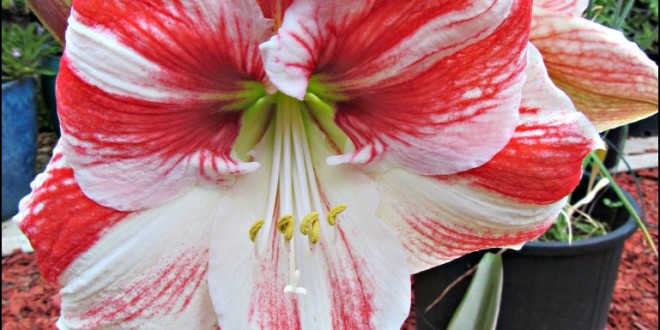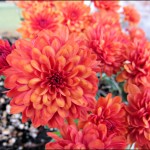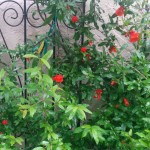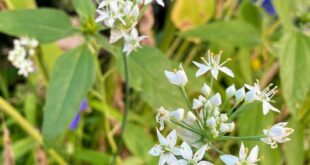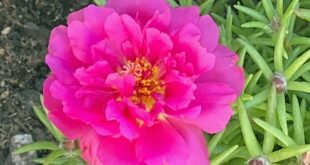The garden exploded in April with a full spread of colors. We had the full range of spring flowers and now the summer flowers have started.
In May I will harvest the winter root vegetables (beets and carrots); finish moving the 24 tomato plants to the final large pots; harvest some blackberries and squashes; and try to identify the dozens of flowers that I planted in the dead of winter and have forgotten what they are.
Spring Flowers - California Poppy
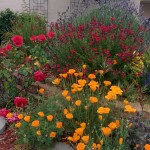 California Poppy is a pretty native wildflower. It is very drought-tolerant and is excellent for xeriscapes. When the plant stops looking pretty, pull it up/break-it-off. The poppy seeds disperse widely so you will be surprised by the next year’s plants. I always have it in my Sunnyvale garden. Adelbert von Chamisso, naturalist aboard the Russian exploring ship “Rurick”, discovered and named the species in 1816. Chamisso named the California poppy Eschscholzia californica in honor of J. F. Eschscholtz, the ship’s surgeon and entomologist.
California Poppy is a pretty native wildflower. It is very drought-tolerant and is excellent for xeriscapes. When the plant stops looking pretty, pull it up/break-it-off. The poppy seeds disperse widely so you will be surprised by the next year’s plants. I always have it in my Sunnyvale garden. Adelbert von Chamisso, naturalist aboard the Russian exploring ship “Rurick”, discovered and named the species in 1816. Chamisso named the California poppy Eschscholzia californica in honor of J. F. Eschscholtz, the ship’s surgeon and entomologist.Spring Flowers - Red Salvia
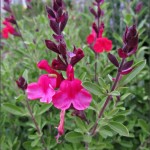 Red salvia (Salvia splendens) fills garden beds and patio pots across the country each summer with its brilliant red, upright blossoms. Though a perennial in U.S. Department of Agriculture plant hardiness zones 11 and 12, red salvia is commonly grown as an annual in other zones. Unless your landscaping plans call for hundreds of these fiery beauties or an uncommon cultivar, you don’t need to start red salvia from seed. The plants are widely available each spring from nurseries and home stores in inexpensive multipacks. Plant when soil has warmed to 70 degrees F.
Red salvia (Salvia splendens) fills garden beds and patio pots across the country each summer with its brilliant red, upright blossoms. Though a perennial in U.S. Department of Agriculture plant hardiness zones 11 and 12, red salvia is commonly grown as an annual in other zones. Unless your landscaping plans call for hundreds of these fiery beauties or an uncommon cultivar, you don’t need to start red salvia from seed. The plants are widely available each spring from nurseries and home stores in inexpensive multipacks. Plant when soil has warmed to 70 degrees F.Spring Flowers - Catmint
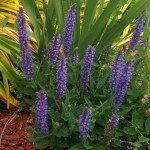
Walker’s Low Flower, aka Catmint. Catmint is one of the toughest perennials you can grow. It’s a proven performer during hot, dry weather, and the silvery foliage and blue flowers look great most of the season. Deadhead or cut back hard after first flush of bloom to encourage more flowers. Average, well-drained soil is usually sufficient. Tall types may need gentle staking; it sometimes seeds freely. The spring 2016 crop is great due to the wet El Nino winter in Sunnyvale.
Spring Flowers - Spanish Lavender
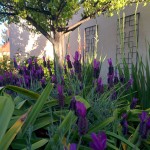 Lavandula stoechas is also known as Spanish or French Lavender. It smells good and attracts bees, butterflies, and hummingbirds. Like other lavenders, it is associated with hot, dry, sunny conditions in alkaline soils. Spanish Lavender is more fragile than common lavender (Lavandula angustifolia), as it is less winter hardy; but harsher and more resinous in its oils. Lavender needs full sun and soil that is very well-draining. Once established, the plants tolerate dry conditions but they don’t tolerate wet soil. Loose, sandy soil is best. The long blades are from Pink Lady Amaryllis plants. That foliage dies off in April and then the flowers appear in August.
Lavandula stoechas is also known as Spanish or French Lavender. It smells good and attracts bees, butterflies, and hummingbirds. Like other lavenders, it is associated with hot, dry, sunny conditions in alkaline soils. Spanish Lavender is more fragile than common lavender (Lavandula angustifolia), as it is less winter hardy; but harsher and more resinous in its oils. Lavender needs full sun and soil that is very well-draining. Once established, the plants tolerate dry conditions but they don’t tolerate wet soil. Loose, sandy soil is best. The long blades are from Pink Lady Amaryllis plants. That foliage dies off in April and then the flowers appear in August.Summer Flowers - Watsonia
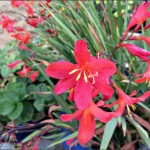 Our Watsonia is naturalized so it comes back every year. Watsonia is a genus of approximately 50 species of evergreen or perennial flowering plants. Watsonia plants vary in height depending on the species, but most varieties have long, narrow leaves and colorful white, orange, yellow, pink or red blossoms that grow from tall flower spikes. They add a touch of character to cottage and courtyard gardens, as well as making attractive container or patio plants.
Our Watsonia is naturalized so it comes back every year. Watsonia is a genus of approximately 50 species of evergreen or perennial flowering plants. Watsonia plants vary in height depending on the species, but most varieties have long, narrow leaves and colorful white, orange, yellow, pink or red blossoms that grow from tall flower spikes. They add a touch of character to cottage and courtyard gardens, as well as making attractive container or patio plants.
Summer Flowers - Alstroemeria
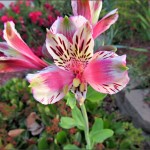 Also known as Peruvian lily or Lily of the Incas, Alstroemeria is a low-maintenance perennial that produces big, dramatic blooms in a variety of vibrant colors from mid to late summer. The blooms are well suited for bouquets, adding a breathtaking blast of color to the indoor environment. At maturity, the stately, upright plants reach heights of 2 to 3 feet. Alstroemeria is suitable for U.S. Department of Agriculture growing zones 7 through 11. The plant grows from tubers just beneath the soil. Ours has spread about 8 feet from its original home 10 years ago.
Also known as Peruvian lily or Lily of the Incas, Alstroemeria is a low-maintenance perennial that produces big, dramatic blooms in a variety of vibrant colors from mid to late summer. The blooms are well suited for bouquets, adding a breathtaking blast of color to the indoor environment. At maturity, the stately, upright plants reach heights of 2 to 3 feet. Alstroemeria is suitable for U.S. Department of Agriculture growing zones 7 through 11. The plant grows from tubers just beneath the soil. Ours has spread about 8 feet from its original home 10 years ago.Spring Flowers - Love-in-the-Mist
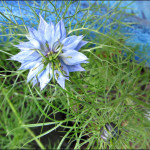 Love-in-a-mist is a popular cool weather annual that features solitary blue flowers (to 1 1/2” wide) atop stems clad with finely-cut, thread-like leaves. Each solitary flower appears to sit on a bed of lacy (and misty) foliage, hence the common name. Plants typically grow to 1.5-2’ tall. Flowers give way to unusual, egg-shaped, horned seed capsules (to 1” diameter) that are covered with bristles. Stems with dried seed capsules make excellent additions to dried flower arrangements.
Love-in-a-mist is a popular cool weather annual that features solitary blue flowers (to 1 1/2” wide) atop stems clad with finely-cut, thread-like leaves. Each solitary flower appears to sit on a bed of lacy (and misty) foliage, hence the common name. Plants typically grow to 1.5-2’ tall. Flowers give way to unusual, egg-shaped, horned seed capsules (to 1” diameter) that are covered with bristles. Stems with dried seed capsules make excellent additions to dried flower arrangements.Spring Flowers - Purple Trumpet Vine
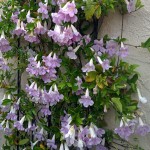
The Purple Trumpet vine has really benefited from all of our El Nino winter rain in Sunnyvale. The trumpet vine flower is great for attracting hummingbirds to the landscape. The beautiful tubular flowers range in color from yellow to orange or red or purple. Blooming on the trumpet vine plant takes place throughout summer and into fall, though blooming may be limited for those planted in shady locations. Following its flowering, trumpet vines produce attractive bean-like seedpods.
Spring Flowers - Mums
A gardening favorite, the mum (Dendranthema spp.) is often a staple in the fall and early winter garden, providing bold, large blossoms during what can be a drab time of year. Ours are still benefiting from the El Nino rains in April. Hardy in U.S. Department of Agriculture plant hardiness zones 5 through 9, mums are commonly grown as annuals in all climates where they are planted and enjoyed for just one season.
Spring Flowers - Milkweed
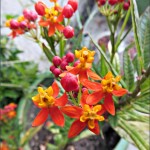 This milkweed attracts eastern tiger swallowtails, giant swallowtails, hummingbirds, painted ladies, pipevine swallowtails, queens, wasps, and more. Southern California, Florida and Texas gardeners should consider cutting back tropical plants to the ground in fall to cut down the spread of OE and to encourage the monarchs to finish their fall migration. I have never seen Monarch butterflies in my Sunnyvale garden so I do not see any risk.
This milkweed attracts eastern tiger swallowtails, giant swallowtails, hummingbirds, painted ladies, pipevine swallowtails, queens, wasps, and more. Southern California, Florida and Texas gardeners should consider cutting back tropical plants to the ground in fall to cut down the spread of OE and to encourage the monarchs to finish their fall migration. I have never seen Monarch butterflies in my Sunnyvale garden so I do not see any risk.
Summer Flowers - Calendula
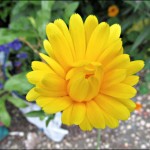 Edible, ornamental and strikingly colorful, calendula (Calendula officinalis) works in the herb garden, vegetable garden and flower garden. Calendula, also commonly called pot marigold, is a cool-season annual flower that grows well in fall, winter and early spring in mild coastal areas and Mediterranean gardens. Add calendula to border areas and cottage gardens for its striking color. In the herb and vegetable garden, calendula attracts beneficial insects and you can harvest the petals to sprinkle on desserts and salads. Calendula is a genus of about 15–20 species of annual and perennial herbaceous plants in the daisy family.
Edible, ornamental and strikingly colorful, calendula (Calendula officinalis) works in the herb garden, vegetable garden and flower garden. Calendula, also commonly called pot marigold, is a cool-season annual flower that grows well in fall, winter and early spring in mild coastal areas and Mediterranean gardens. Add calendula to border areas and cottage gardens for its striking color. In the herb and vegetable garden, calendula attracts beneficial insects and you can harvest the petals to sprinkle on desserts and salads. Calendula is a genus of about 15–20 species of annual and perennial herbaceous plants in the daisy family.
Spring Flowers - Clematis
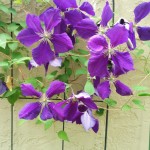 Between 200 and 300 species and several thousand hybrids comprise the glorious flowering clematis (Clematis) plants of the buttercup (Ranunculaceae) family. Though usually deciduous vines, evergreen vines and herbaceous shrubs round out clematis choices. The main attraction for home gardeners is the spectacular floral displays put on by clematis in wide ranges of flower colors, sizes and forms. Ours grows in a 3-inch trench in a shady back corner of the yard.
Between 200 and 300 species and several thousand hybrids comprise the glorious flowering clematis (Clematis) plants of the buttercup (Ranunculaceae) family. Though usually deciduous vines, evergreen vines and herbaceous shrubs round out clematis choices. The main attraction for home gardeners is the spectacular floral displays put on by clematis in wide ranges of flower colors, sizes and forms. Ours grows in a 3-inch trench in a shady back corner of the yard.
Spring Flowers - Amaryllis
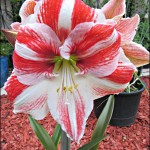 Around Christmas many people receive an Amaryllis. It is a large bulb that blooms indoors in winter (with some assistance). Most people discard them after the bloom. I transplanted mine into a small pot outdoors. The amaryllis (Hippeastrum) blooms throughout the spring without being too picky as to light and soil requirements. You’ll be rewarded by flowering stalks up to 24 inches tall if you keep the bulbs warm in the winter and pay attention to their water and fertilizer needs. The blossoms are huge!
Around Christmas many people receive an Amaryllis. It is a large bulb that blooms indoors in winter (with some assistance). Most people discard them after the bloom. I transplanted mine into a small pot outdoors. The amaryllis (Hippeastrum) blooms throughout the spring without being too picky as to light and soil requirements. You’ll be rewarded by flowering stalks up to 24 inches tall if you keep the bulbs warm in the winter and pay attention to their water and fertilizer needs. The blossoms are huge!
Spring Flowers - Mulberry
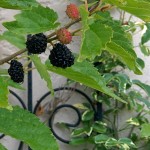 This bush form of mulberry continuously produces sweet blackberry-like fruit throughout the season. A great choice for container gardening; minor pruning will keep the plant compact. Mature height is 6 to 8 feet if grown in the ground.
This bush form of mulberry continuously produces sweet blackberry-like fruit throughout the season. A great choice for container gardening; minor pruning will keep the plant compact. Mature height is 6 to 8 feet if grown in the ground.I grow it in a 20 inch wide and deep ceramic pot. It is about 6-7 feet tall from the soil.
The mulberry flowers in March are almost microscopic. In mid-April the fruit is the size of pencil erasers. The fruits start darkening and, unlike blackberries, continue to grow. The berries got sweeter. Then the berries started disappearing. I asked the robins about it but I couldn’t get a peep out of them.
Summer vegetables - Patty Pan Squash
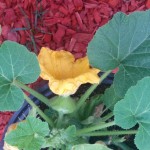 I bought three types of squashes this April. Pattypan squash is a variety of summer squash notable for its small size, round and shallow shape, and scalloped edges, somewhat resembling a small toy top, or flying saucer. As with all members of the cucumber family, it is best to plant two or three plants a few inches apart to promote cross-pollination and more fruits. We have enought that I could even just harvest the flowers (see http://www.thekitchn.com/five-ways-to-eat-squash-blosso-87564)
I bought three types of squashes this April. Pattypan squash is a variety of summer squash notable for its small size, round and shallow shape, and scalloped edges, somewhat resembling a small toy top, or flying saucer. As with all members of the cucumber family, it is best to plant two or three plants a few inches apart to promote cross-pollination and more fruits. We have enought that I could even just harvest the flowers (see http://www.thekitchn.com/five-ways-to-eat-squash-blosso-87564)
Summer Vegetables- Rhubarb
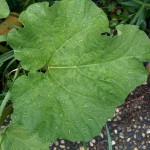 Rhubarb is a perennial vegetable that grows well in most of the United States. Rhubarb is used in pies, tarts and sauces. Rhubarb should be planted at the end of one side of the garden where it will not be disturbed since it may be productive for five years or more. A half-dozen plants will provide enough rhubarb for a family of four.
Rhubarb is a perennial vegetable that grows well in most of the United States. Rhubarb is used in pies, tarts and sauces. Rhubarb should be planted at the end of one side of the garden where it will not be disturbed since it may be productive for five years or more. A half-dozen plants will provide enough rhubarb for a family of four.Only the stalk is eaten. Do NOT eat the green leaves which are poisonous.
Spring Vegetables- Carrots
 I have tried growing carrots several times over the years. I have to grow them in containers because I don’t have much ground soil. I grow them in a 19-inch deep pot so it is deep enough for the expected length of the carrots. Most years I planted in December or January. The carrots were puny. This year I planted my carrot seeds earlier (in November). I started harvesting at the end of April 2016 (5 months).The results are much larger carrots. I will harvest the rest of the carrots (a few dozen) in May. I need the pot for my many tomato plants.
I have tried growing carrots several times over the years. I have to grow them in containers because I don’t have much ground soil. I grow them in a 19-inch deep pot so it is deep enough for the expected length of the carrots. Most years I planted in December or January. The carrots were puny. This year I planted my carrot seeds earlier (in November). I started harvesting at the end of April 2016 (5 months).The results are much larger carrots. I will harvest the rest of the carrots (a few dozen) in May. I need the pot for my many tomato plants.
Stone Fruit- Cherries, Apricots, Plums, Nectarines
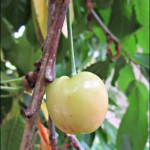 The cherry tree was promising in early spring but my hopes are dashed again. The tree is large and produces many blossoms. But few fruits and most of them drop off. I tried adding a second tree of a different variety but still no luck. Last year I grafted about 6 scions onto the tree of other varieties. Four of the scions took and produced blossoms this year. But there is only one cluster of cherries on the tree (on one of the new scions). I think the problem is not enough chill-hours. Lapins and Bing cherries need about 500 to 700 hours of temperatures below 50 degrees to trigger the hormones to promote fruiting. We are just not getting enough cold winter nights.
The cherry tree was promising in early spring but my hopes are dashed again. The tree is large and produces many blossoms. But few fruits and most of them drop off. I tried adding a second tree of a different variety but still no luck. Last year I grafted about 6 scions onto the tree of other varieties. Four of the scions took and produced blossoms this year. But there is only one cluster of cherries on the tree (on one of the new scions). I think the problem is not enough chill-hours. Lapins and Bing cherries need about 500 to 700 hours of temperatures below 50 degrees to trigger the hormones to promote fruiting. We are just not getting enough cold winter nights.
Our two apricot trees were not sprayed with fungicide this winter and they both suffered from the fungus effects: withered leaves and mummy fruit. I mitigated the damage by removing lots of affected branches and fruits. We will still have plenty of apricots for us and the squirrels.
Our three plum trees are doing well. There are many formed fruits of good size (it helps to water the trees!)
Our two nectarine trees also suffered from peach leaf curl that damages leaves and fruit. I bit the bullet and got rid of one of the trees and re-used the large pot for the Panoche fig that Adam gave me.
Pomegranates
Other fruits
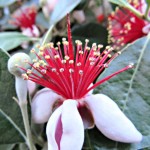 This past winter I severely pruned back our Feijoa tree. The tree is still fine with many of its spectacular red flowers. The petals are edible – they have a cinnamon taste and a spongy texture.
This past winter I severely pruned back our Feijoa tree. The tree is still fine with many of its spectacular red flowers. The petals are edible – they have a cinnamon taste and a spongy texture.
Our Baerrs lime tree is covered with dozens of small fruit. Our Meyers lemon tree has its usual large crop. I pruned back the Washington orange tree to keep it tidy in its 3 foot-wide trench. Our 40 year-old grapefruit tree and tangerine tree are doing well.
Our blueberry bushes continue to struggle. I haven’t hit on the right combination of soil acidity, watering, fertilizing, sunlight.
Our dwarf asian pear tree has only one fruit (sigh).
